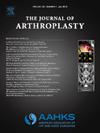使用术前规划工具评估股骨窦内两种临床干管配合理念:混合方法是否最佳?
IF 3.4
2区 医学
Q1 ORTHOPEDICS
引用次数: 0
摘要
背景:全髋关节置换术(THA)改变了患者的生活,但不断变化的期望值和术后足底角度变化的数量凸显了精确部件定位的必要性。本研究的目的是使用三维(3D)术前规划来评估三种THA系统的茎干对齐和方向,并使用两种不同的茎干配合算法。假设不同的骨干对齐方式会使所有三种系统的骨干方向和在管道内的位置发生相似的变化:本研究引入了一种新颖的三维术前规划工具,比较了两种不同的手术柄在管道内的拟合理念,即 "管道拟合"(CF)和 "管道拟合"(CF):方法:本研究采用了一种新颖的三维术前规划工具,比较了两种不同的手术柄在管道内的配合理念:"管道配合"(CF)和 "解剖配合"(AF)。我们使用这两种理念为10名受试者虚拟植入了三种不同的THA植入系统,共评估了60次管腔内的配合。管道配合 "理念旨在最大限度地减少皮质骨的去除。相比之下,"解剖配合 "理念优先考虑的是使植入头与解剖头中心对齐:详细分析显示,AF导致的固定主要发生在骨干的内侧,而CF在内侧和外侧之间的分布更为均匀。与CF理念(3.0至6.0毫米)相比,AF理念使植入头更接近解剖中心(2.0至2.1毫米)(P < 0.01)。AF使所有骨干的方向保持中立(0°),而CF则表现出更大的错位(2.0至7.0°)(P < 0.02)。与CF(0.02至0.06立方厘米)相比,AF需要切除更多的骨头(0.13至0.46立方厘米)(P < 0.01):结论:研究结果突出了三维规划的重要性,强调了其改善THA中茎突对齐的潜力。这项研究的结果可能会提倡使用机器人手术进行术前三维规划,在保持股骨头解剖复位的同时,规划骨干在管道内的位置。本文章由计算机程序翻译,如有差异,请以英文原文为准。
Evaluation of Two Clinical Stem-Fit Philosophies Within the Femoral Canal Using a Preoperative Planning Tool: Could a Hybrid Approach Be Best?
Background
Total hip arthroplasty (THA) has transformed patient lives, yet evolving expectations and the number of postoperative foot angle changes have underscored the need for precise component positioning. The objective of this study was to use 3-dimensional (3D) preoperative planning to evaluate stem alignment and orientation for three THA systems using two different stem-fit algorithms. It was hypothesized that the different stem alignments would yield similar changes in stem orientation and placement within the canal for all 3 systems.
Methods
This study introduced a novel 3D preoperative planning tool, comparing two different surgical stem-fit philosophies within the canal: “canal fit” (CF) and “anatomical fit” (AF). We virtually implanted 10 subjects with three different THA implant systems using both philosophies, evaluating 60 total fits within the canals. The CF philosophy aimed to minimize cortical bone removal. In contrast, the AF philosophy prioritized aligning the implanted head with the anatomical head center.
Results
Detailed analyses revealed that AF led to fixation occurring mainly on the medial aspect of the stem, while CF exhibited a more even distribution between medial and lateral sides. The AF philosophy achieved significantly closer placement of the implanted head to the anatomical center (2.0 to 2.1 mm) compared to the CF philosophy (3.0 to 6.0 mm) (P < 0.01). The AF resulted in neutral stem orientation (0°) across all stems, whereas the CF exhibited greater malrotation (2.0 to 7.0°) (P < 0.02). The AF required more bone removal (0.13 to 0.46 cm³) than the CF (0.02 to 0.06 cm³) (P < 0.01).
Conclusions
The findings underscore the importance of 3D planning, emphasizing its potential to improve stem version alignment in THA. The results from this study may advocate 3D preoperative planning with robotic surgery to plan stem placement within the canal while maintaining anatomical femoral head restoration.
求助全文
通过发布文献求助,成功后即可免费获取论文全文。
去求助
来源期刊

Journal of Arthroplasty
医学-整形外科
CiteScore
7.00
自引率
20.00%
发文量
734
审稿时长
48 days
期刊介绍:
The Journal of Arthroplasty brings together the clinical and scientific foundations for joint replacement. This peer-reviewed journal publishes original research and manuscripts of the highest quality from all areas relating to joint replacement or the treatment of its complications, including those dealing with clinical series and experience, prosthetic design, biomechanics, biomaterials, metallurgy, biologic response to arthroplasty materials in vivo and in vitro.
 求助内容:
求助内容: 应助结果提醒方式:
应助结果提醒方式:


